PENTAGON FOUNDATION DAMAGE?
Adam Larson / Caustic Logic
The Frustrating Fraud
January 1 2008The Foundations of the No-Impact TheoryAmong the clues tht led
Citizen Investigative Team (CIT) to start digging into eyewitness accounts of the Pentagon attack is the 'anomalous physical evidence' that doesn't match a 757 strike. Drawing on analysis largely worked out by his cohort Aldo Marquis, CIT’s Craig Ranke posted as AboveTopSecret.com Conspiracy Master “Jack Tripper”
seven physical clues of massive deception of the no-plane impact variety. Among these was the lack of discernable damage to the Pentagon’s first floor slab/foundation, where the left engine was said to have hit at about ground level:
“Why is the floor undamaged, if a 757 just tilted it's left wing, dropped down on the ground, and skidded under the first floor? If the left wing/engine allegedly tilted and went through/under the first floor. Why is the foundation, the shoring is resting upon, still intact????"
He showed four high resolution photos with spans of the foundation on the left side disturbingly smooth and intact. This shot shows an area to the left of the engine impact point, a fact hidden by the compressing term “wing/engine.” Other than some minor chipping, there is no damage, not that I’d expect any there.
Looking at the four photos they used for the point, and noting that only one spot really matters to me (explained below), that spot is off-frame in the shot above, too far away to see in another, buried by debris in the photo below (red additions mine), and in the fourth… we’ll get back to that one. The bend of
column 9aa I marked for my hypothetical wing placement, which puts the engine over near column line 11 and just about the right level to barely hit or barely miss the foundation edge.
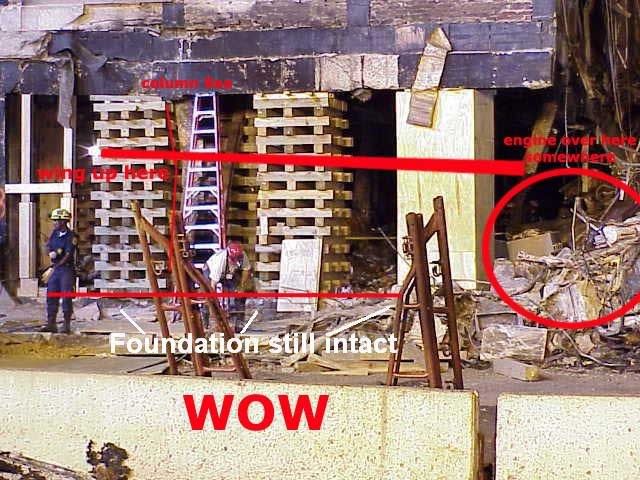 The Left-Wing Underground
The Left-Wing Underground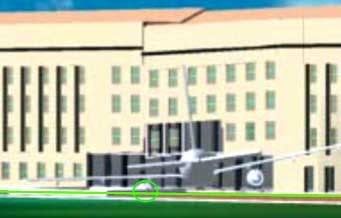
In this graphic by the American Society of Civil Engineers was used in their 2002
Pentagon Building Performance Report to illustrate how the plane impacted the building, the left engine is centered just right of column 11aa (aa meaning outermost row on a column line) with columns 10, 9, and 8aa visible in black to its left. The main problem with this picture, as I have highlighted in green, is that the engine appears to be about halfway underground at point of impact. CIT of course have not passed up the chance to comment on this, as Ranke points out in
a more recent thread, “in fact this image from the ASCE report actually depicts the left engine at least half way burrowed into the foundation. But the perpetrators forgot to simulate any damage to the foundation. OOPS!”
This is indeed too low to have simply nicked and partly sheared
the ground-level vent structure as seen, and too low to have entered the building as said. In the pictured scenario, it would have exhausted and buried itself, but not before smashing up the reinforced concrete foundation/first floor slab (in reality almost certainly a floor above basement levels, not on dirt). This did not happen, and neither was the left wing edge that low, judging by the bend of column 9aa. My opinion is this graphic is simply wrong on that spot, due to an imprecise modeling that ignored crash dynamics where the intact profile seen here breaks up in stages. But judging by the damage to the vent structure retaining wall, a glancing blow at least with this horizontal concrete structure seems likely. As the plane was generally
above the ground by all accounts at impact, no other spots right at or shortly after impact should be similarly damaged – only this one spot, if even that, should be expected to bear a mark.
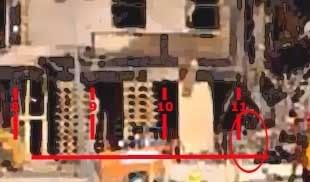
H ere is a simplified rendition of the post-collapse left-side overhang, shored with wooden structures. Columns 9 and 8aa are apparently still intact, while 10 and 11 are obliterated. The missing columns flanking the expansion joint at CL 11 would roughly mark the entry point of the 757's left engine, somewhere in or quite near that oval. To the immediate right of that is the section that collapsed before it could be shored. Keep these basic locations in mind below.
Muddying The Issue: Mud Clearly this is the best and prime spot to look for ground level damage at the impact point, but for a moment let’s step back and realize this is only one small part of the floor passed over by the plane. In a 757 impact scenario, initially the massive plane’s trajectory would keep most of it traveling forward just above the floor, but exploding, scattering remnants would move in all directions averaged together with their diminishing forward velocity. So I’d suspect some slab damage under the whole plane and beyond, angled at about 39 degrees, and showing up especially further in as its fragments started grinding to a halt. Though they do generally ignore the issue, the ASCE does mention "effective frictional and impact forces on the first-floor slab" as one of the counter-forces responsible for "the short stopping distance for the aircraft." [p 40]
However I’d expect this damage in any one spot to be fairly minor, glancing. Some parts of differing mass would leave scrapes, cracks, and chips that cleared concrete might show. After looking at
hundreds of photos by Jocelyn Augustino, I haven't seen any conclusive damage yet, and precious little cleared concrete. Instead we get a less than clear view prevailing: dirt, grit and tiny debris wetted down by fire hoses, broken water mains, whatever. Photos from further in shows this buildup as uneven, wet in spots and dry in others, and apparently an inch or more deep in places.
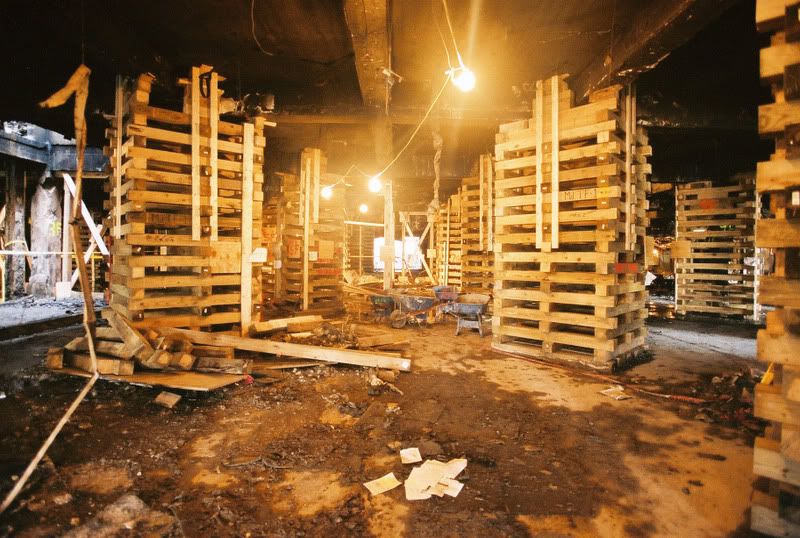
This shot shows such mud and puddles extending to just behind the area we’ve been looking at. Note the tire tracks of the bulldozers, which regularly drove in and out to dump debris large and small over that edge and form that sloping pile we’ve been looking at.
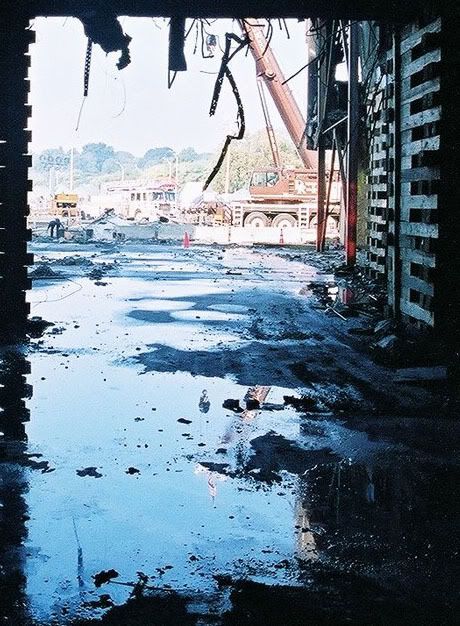
Noting the clean-scraped surface of CIT’s smooth foundation shots, it seems likely this area was cleared by the shovel of a small bulldozer like this one. These were seen all around the Pentagon during the cleanup
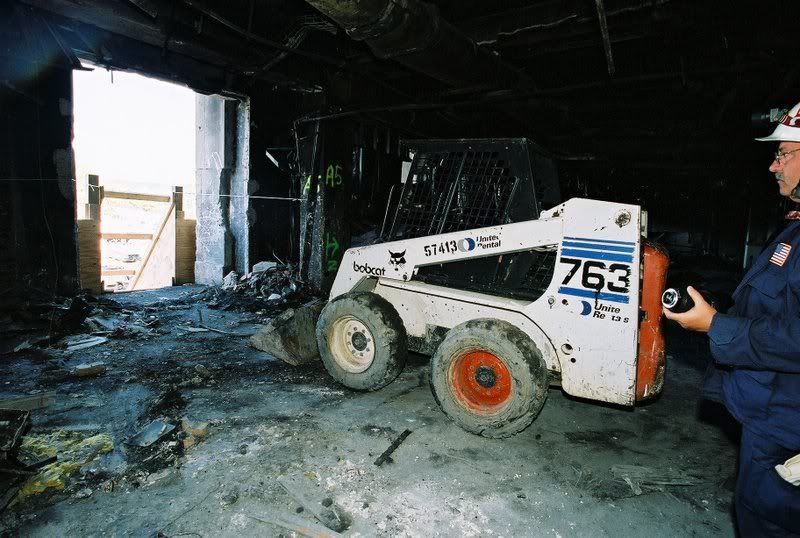
This scraping over the muddy surface would fill in the minimal damage to be expected there, leaving it nearly as smooth as fresh concrete and probably a similar color, but perhaps darker with burnt material. Note scrape marks parallel to the straight edge of the cleared space across this dark, sludgy surface. Of all things, this is to be the key evidence that
'puts to rest' the 757 impact theory and prove 9/11 an inside job. It does look counter-intuitive, smooth enough some debunkers have speculated on fresh concrete, but that's about it.
 Foundation Damage Found?
Foundation Damage Found?
So seeing how little there is to be seen of this alleged smooth concrete, and returning to he best photo for seeing the
apparent smoothness CIT offered, this also shows us the clearest shot of the areawhere we might see real damage simply grime couldn’t mask; we see the wooden box placed to the left of column 11aa's onetime position - where the column's base and surrounding foundation had been. Right there, at the engine’s low-pass point, still a pile of rubble just above – no wait,
at? Below? - ground level.
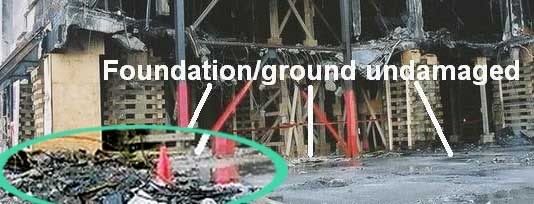
A small pile of broken concrete? curved rebar? At the edge of the otherwise cleared floor and marked like some unavoidable obstruction? (magnified and enhanced) Is that the foundation itself, damaged, right where that low engine is said to have passed?
Some point out that the rubble pile is halfway outside the building, but the other half is of course inside, where the foundation should be. Admittedly the resolution isn't good enough to tell exactly what's going on here. It could be a pile of debris again obscuring the floor just at that spot, pouring over the edge of an intact foundation, or a pile of rubble that had
been the foundation. (see below for more detailed analysis)
Coulumn Remnants? 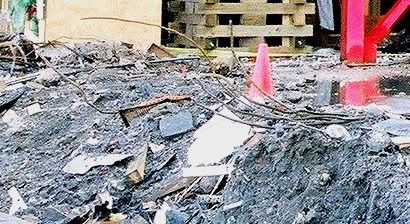
This area of engine impact is supposed to be right-centered on column line 11. On the right side of this area can be seen it seems five very long, curving bars, protruding from a damaged area, with a riveted metal scrap hanging off one. Although essentially horizontal, these curving bars are too long to be from the floor slab which ends right there, and the clustering is similar to that of a support column, perhaps 12aa. These have at core typically six bars wrapped with a spiraling seventh, here stripped down to the bottom of their concrete infill/casing. Craig’s panned out photo usefully captures the tip of another such set to the right, with the outer spiral still partly in place:

Despite that these are not vertical, it’s not a good clue for ‘columns blown out,’ another CIT clue of explosives inside, since there is
no other evidence for that. Additionally these photos are all post-collapse and post-cleanup so can say nothing much about the initial event.
The Wooden ‘Lip’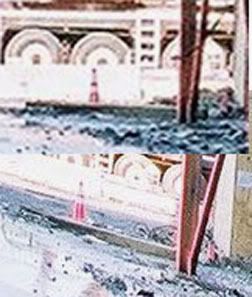
Foundation damage started seeming less likely compared to Craig's debris pile interpretation when I saw the curb-like structure visible in higher resolution shots (just to the left of the solid plywood shoring). This apparently intact lip covers most of the small area I’d thought was perhaps scraped out, and seems to be under the shoring as well, though missing a small portion right there (note the small traffic cone visible). Craig says this “looks more like a simple construction flaw or normal progressive damage that typically happens over decades to foundations as buildings settle etc.” This seemed right until I found another high resolution photo showing this spot from another angle that shows this object is not part of the building at all, but a broken beam of wood set back at least a foot from the edge.
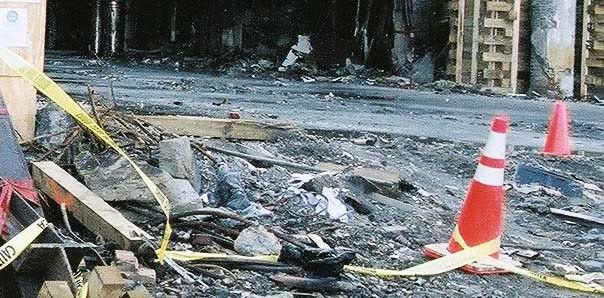 The Slope: More Photos
The Slope: More PhotosThis photo also gives us valuable clues about what is going on with this contentious spot. Compared to a previously analyzed view and establishing correlary objects, we can get a better idea of the perspective and forehortening involved. Damage to the edge is still unclear, but very minor is present and possibly from cleanup activities. Note also the custered rebar from column 11 (circled in yellow), pushed forward, one bar wrapped in cloth, and others pinned down under rubble.


Not so promising for my case: Russel Pickering, at one point anyway, looked at this photo and noted "I don't see any devastation here."
linkThe photo below, also by Augustino, shows the pile catching rays of early morning light. It still looks beneath floor level to me. In fact considering that little dozers were driving in and out from somewhere, it almost seems feasible that this spot would be chosen as an access ramp because the low left engine carved it out for them. It's too-cluttered to seem that's what happened, and rather it looks like the excavation was used as a mini-debris chute, or perhaps an unofficial walk-up ramp like those improvised by 'gofers' on any complex site like this one. Either way, it's a special spot, the only one not scraped clean, and it's right at the spot it should be.
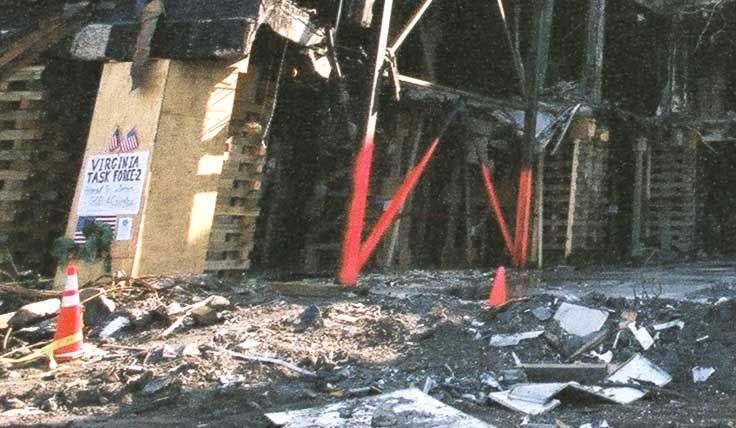





 Column 9 is also visible in figure 9 from FEMA’s Shoring Report (above), again seen from the right, post-collapse, post-fire, but pre-shoring. It’s the “damaged column,” one of the many that necessitated the bracing that report documented. Other photos of column 9 in the report, once the wood went up, are taken head-on and show no evident lateral curve. Figure 16 (left) shows the first of the supports being finished the night after the attack, with the space to the right still left hanging.
Column 9 is also visible in figure 9 from FEMA’s Shoring Report (above), again seen from the right, post-collapse, post-fire, but pre-shoring. It’s the “damaged column,” one of the many that necessitated the bracing that report documented. Other photos of column 9 in the report, once the wood went up, are taken head-on and show no evident lateral curve. Figure 16 (left) shows the first of the supports being finished the night after the attack, with the space to the right still left hanging.  The close-up photo used in the American Society of Civil Engineers’s 2002 Pentagon Building Performance Report shows a column displaying “triple curvature” (shown from the right). Besides three remnants of its original square-sided casing, the angular concrete is gone, the column “stripped to spiral reinforcements.”
The close-up photo used in the American Society of Civil Engineers’s 2002 Pentagon Building Performance Report shows a column displaying “triple curvature” (shown from the right). Besides three remnants of its original square-sided casing, the angular concrete is gone, the column “stripped to spiral reinforcements.” 
 But this graphic used in the ASCE’s report seems to disagree, with the left engine centered just to right of column 11aa with columns 10, 9, and 8aa visible to left. In addition to there being no evidence of the left engine entering well below ground level as shown, the wing crosses low on column 9 in this mock-up, almost certainly too low to have created the bend seen above. It might seem presumptuous of me to question the ASCE's graphic placement, but it seems warranted by this evidence to venture that we have an inaccurate graphic here.
But this graphic used in the ASCE’s report seems to disagree, with the left engine centered just to right of column 11aa with columns 10, 9, and 8aa visible to left. In addition to there being no evidence of the left engine entering well below ground level as shown, the wing crosses low on column 9 in this mock-up, almost certainly too low to have created the bend seen above. It might seem presumptuous of me to question the ASCE's graphic placement, but it seems warranted by this evidence to venture that we have an inaccurate graphic here. 
























